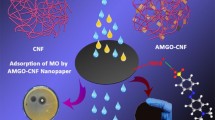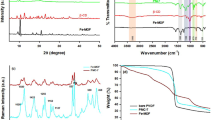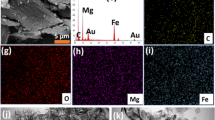Abstract
Pharmaceuticals and personal care products (PPCPs) as typical emerging pollutant have attracted extensive attention due to the risks to human health and environment. As a kind of harmful PPCPs, diclofenac sodium (DCF) has been frequently detected in water environment, which needs to be removed effectively. Herein, we successfully fabricated network structure composite membranes consisting of one-dimensional (1D) well-defined core–shell bacterial cellulose (BC)@MIL-100 (Fe) nanofibers by a simple but effective step-by-step strategy. The BC@MIL-100(Fe) composite membrane has three-dimensional network utilizing bacterial cellulose nanofiber as template, which was observed as the MIL-100(Fe) grew on the nanofiber uniformly and obvious core–shell structure. Impressively, the BC@MIL-100(Fe) not only possessed favorable architecture but also behaved good properties to adsorb DCF from water. As we expected, the as-obtained BC@MIL-100(Fe) composite membrane exhibited convenient recycling, high chemical stability, and short equilibrium time (30 min) with high adsorption capacity (296 mg g−1). Strikingly, in low DCF concentration solution, BC@MIL-100(Fe) composite showed high adsorption efficiency in periodic test, which can still reach 70% after five successive adsorptions without desorption. The results demonstrated that the adsorption mechanism may involve π-π interaction, H-bond interaction, and electrostatic interaction. This work proposes the new finding to understand the removing of DCF from water environment.






Similar content being viewed by others
Data availability
The data that support this study are available in the article and accompanying online supplementary material.
References
Bhadra BN, Seo PW, Jhung SH (2016) Adsorption of diclofenac sodium from water using oxidized activated carbon. Chem Eng J 301:27–34
B Ferrari, Paxéus N, Giudice RL, Pollio A, Garric J (2003) Ecotoxicological impact of pharmaceuticals found in treated wastewaters: study of carbamazepine, clofibric acid, and diclofenac. Ecotoxicol Environ Saf 55:359–370
Canioni R, Roch-Marchal C, Secheresse F, Horcajada P, Serre C, Hardi-Dan M, Ferey G, Greneche JM, Lefebvre F, Chang JS, Hwang YK, Lebedev O, Turner S, Van Tendeloo G (2011) Stable polyoxometalate insertion within the mesoporous metal organic framework MIL-100(Fe). J Mater Chem 21:1226–1233
Cao Y, Chen X, Li X, Wang B (2021) Tuning surface functionalization and pore structure of UiO-66 metal–organic framework nanoparticles for organic pollutant elimination. ACS Appl Nano Mater 4:5486–5495
Chen M, Ren L, Qi K, Li Q, Lai M, Li Y, Li X, Wang Z (2020) Enhanced removal of pharmaceuticals and personal care products from real municipal wastewater using an electrochemical membrane bioreactor. Bioresour Technol 311:123579
Connolly BM, Madden DG, Wheatley AEH, Fairen-Jimenez D (2020) Shaping the future of fuel: monolithic metal–organic frameworks for high-density gas storage. J Am Chem Soc 142:8541–8549
Czaja W, Romanovicz D, Rm B (2004) Structural investigations of microbial cellulose produced in stationary and agitated culture. Cellulose 11:403–411
Gnanasekaran G, Sudhakaran MSP, Kulmatova D, Han J, Arthanareeswaran G, Jwa E, Mok YS (2021) Efficient removal of anionic, cationic textile dyes and salt mixture using a novel CS/MIL-100 (Fe) based nanofiltration membrane. Chemosphere 284:131244
Hasan Z, Jeon J, Jhung SH (2012) Adsorptive removal of naproxen and clofibric acid from water using metal-organic frameworks. J Hazard Mater 209:151–157
Jiang X, Ding W, Li H, Zhang Z, Zhong Z, Liu H, Zheng H (2022) Facile synthesis of Poly(epichlorohydrin-diethylenetriamine) hydrogel for highly selective diclofenac sodium removal. Sep Purif Technol 283:120215
Jing P, Wu B, Han Z, Shi W, Cheng P (2021) An efficient Ag/MIL-100(Fe) catalyst for photothermal conversion of CO2 at ambient temperature. Chin Chem Lett 32:3505–3508
Khan S, Naushad M, Govarthanan M, Iqbal J, Alfadul SM (2022) Emerging contaminants of high concern for the environment: current trends and future research. Environ Res 207:112609
Kovala-Demertzi D, Mentzafos D, Terzis A (1993) Metal complexes of the anti-inflammatory drug sodium [2-[(2,6-dichlorophenyl)amino]phenyl]acetate (diclofenac sodium). Molecular and crystal structure of cadmium diclofenac. Polyhedron 12:1361–1370
Li Y, Liu F, Xia B, Du Q, Zhang P, Wang D, Wang Z, Xia Y (2010) Removal of copper from aqueous solution by carbon nanotube/calcium alginate composites. J Hazard Mater 177:876–880
Li J, Wang X, Zhao G, Chen C, Chai Z, Alsaedi A, Hayat T, Wang X (2018) Metal–organic framework-based materials: superior adsorbents for the capture of toxic and radioactive metal ions. Chem Soc Rev 47:2322–2356
Liang RW, Luo SG, Jing FF, Shen LJ, Qin N, Wu L (2015) A simple strategy for fabrication of Pd@MIL-100(Fe) nanocomposite as a visible-light-driven photocatalyst for the treatment of pharmaceuticals and personal care products (PPCPs). Appl Catal B-Environ 176:240–248
Liang Y, Li C, Chen L, Huo J, Loubidi M, Zhou Y, Liu Y (2021) Microwave-assisted acid-induced formation of linker vacancies within Zr-based metal organic frameworks with enhanced heterogeneous catalysis. Chin Chem Lett 32:787–790
Lin JW, Zhan YH, Zhu ZL (2011) Adsorption characteristics of copper (II) ions from aqueous solution onto humic acid-immobilized surfactant-modified zeolite. Colloids Surf a-Physicochem Eng Asp 384:9–16
Liu S, Zhao Y, Wang T, Liang N, Hou X (2019) Core-Shell Fe3O4@MIL-100(Fe) Magnetic Nanoparticle for Effective Removal of Meloxicam and Naproxen in Aqueous Solution. J Chem Eng Data 64:2997–3007
Luo P, Zhao Y, Zhang B, Liu J, Yang Y, Liu J (2010) Study on the adsorption of Neutral Red from aqueous solution onto halloysite nanotubes. Water Res 44:1489–1497
Luo Y, Guo W, Ngo HH, Nghiem LD, Hai FI, Zhang J, Liang S, Wang XC (2014) A review on the occurrence of micropollutants in the aquatic environment and their fate and removal during wastewater treatment. Sci Total Environ 473–474:619–641
Mallakpour S, Nikkhoo E, Hussain CM (2022) Application of MOF materials as drug delivery systems for cancer therapy and dermal treatment. Coord Chem Rev 451:214262
Ouda M, Kadadou D, Swaidan B, Al-Othman A, Al-Asheh S, Banat F, Hasan SW (2021) Emerging contaminants in the water bodies of the Middle East and North Africa (MENA): a critical review. Sci Total Environ 754:142177
Paucar NE, Kim I, Tanaka H, Sato C (2019) Ozone treatment process for the removal of pharmaceuticals and personal care products in wastewater. Ozone: Sci Eng 41:3–16
Qian H, Yu G, Hou Q, Nie Y, Bai C, Bai X, Wang H, Ju M (2021) Ingenious control of adsorbed oxygen species to construct dual reaction centers ZnO@FePc photo-Fenton catalyst with high-speed electron transmission channel for PPCPs degradation. Appl Catal B 291:120064
Shao W, Liu H, Liu XF, Wang SX, Zhang R (2015) Anti-bacterial performances and biocompatibility of bacterial cellulose/graphene oxide composites. RSC Adv 5:4795–4803
Suriyanon N, Punyapalakul P, Ngamcharussrivichai C (2013) Mechanistic study of diclofenac and carbamazepine adsorption on functionalized silica-based porous materials. Chem Eng J 214:208–218
Wang T, He J, Lu J, Zhou Y, Wang Z, Zhou Y (2022) Adsorptive removal of PPCPs from aqueous solution using carbon-based composites: a review. Chin Chem Lett 33:3585–3593
Wei X, Wang Y, Chen J, Xu F, Liu Z, He X, Li H, Zhou Y (2020) Adsorption of pharmaceuticals and personal care products by deep eutectic solvents-regulated magnetic metal-organic framework adsorbents: performance and mechanism. Chem Eng J 392:124808
Wu L, Du C, He J, Yang Z, Li H (2020) Effective adsorption of diclofenac sodium from neutral aqueous solution by low-cost lignite activated cokes. J Hazard Mater 384:121284
Zhang F, Zhang H, Chen R, Liu Q, Liu J, Wang C, Sun Z, Wang J (2019) Mussel-inspired antifouling magnetic activated carbon for uranium recovery from simulated seawater. J Colloid Interface Sci 534:172–182
Zhang Y, Zheng H, Zhang P, Zheng X, Zuo Q (2021) A facile method to achieve dopamine polymerization in MOFs pore structure for efficient and selective removal of trace lead (II) ions from drinking water. J Hazard Mater 408:124917
Zhao X, Zheng Y, Hu S, Qiu W, Jiang J, Gao C, Xiong J, Lu H, Quan F (2021) Improving urban drainage systems to mitigate PPCPs pollution in surface water: a watershed perspective. J Hazard Mater 411:125047
Zheng J, Pang K, Liu X, Li S, Song R, Liu Y, Tang Z (2020) Integration and synergy of organic single crystals and metal–organic frameworks in core–shell heterostructures enables outstanding gas selectivity for detection. Adv Funct Mater 30:2005727
Zhong J, Zhou J, Xiao M, Liu J, Shen J, Liu J, Ren S (2022) Design and syntheses of functionalized copper-based MOFs and its adsorption behavior for Pb(II). Chin Chem Lett 33:973–978
Zhu BJ, Yu XY, Jia Y, Peng FM, Sun B, Zhang MY, Luo T, Liu JH, Huang XJ (2012) Iron and 1,3,5-benzenetricarboxylic metal-organic coordination polymers prepared by solvothermal method and their application in efficient As(V) removal from aqueous solutions. J Phys Chem C 116:8601–8607
Funding
The work was supported by the National Natural Science Foundation of China (Grant No. 51778618, 52070192).
Author information
Authors and Affiliations
Contributions
Rong Cheng: Conceptualization; study design; investigation; funding acquisition; writing, original draft; writing, review and editing; supervision. Weilong Li: Investigation, data curation, methodology, writing–original draft. Jinlin Wang: Methodology, investigation, data processing. Jie Li: Writing–review and editing. Jianzhong Zheng: Data processing and analysis, writing–review and editing. Xiang Zheng: Supervision, project administration, writing–review and editing.
Corresponding author
Ethics declarations
Ethics approval
The study does not involve any human or animal subject study.
Consent to participate
All authors reviewed and approved the final manuscript.
Consent for publication
All authors agree to publish this manuscript in your journal.
Conflict of interest
The authors declare no competing interests.
Additional information
Responsible Editor: Angeles Blanco
Publisher's note
Springer Nature remains neutral with regard to jurisdictional claims in published maps and institutional affiliations.
Supplementary Information
Below is the link to the electronic supplementary material.
Rights and permissions
Springer Nature or its licensor holds exclusive rights to this article under a publishing agreement with the author(s) or other rightsholder(s); author self-archiving of the accepted manuscript version of this article is solely governed by the terms of such publishing agreement and applicable law.
About this article
Cite this article
Cheng, R., Li, W., Wang, J. et al. Design strategy of self-assembled BC@MIL-100(Fe) composite membrane for the efficient removal of diclofenac sodium from water. Environ Sci Pollut Res 30, 19356–19366 (2023). https://doi.org/10.1007/s11356-022-23059-9
Received:
Accepted:
Published:
Issue Date:
DOI: https://doi.org/10.1007/s11356-022-23059-9




